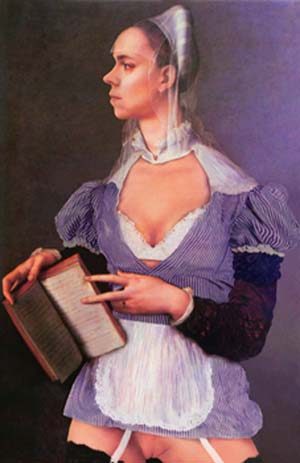This match may seem a little less peculiar with the knowledge that Korman was born and raised in Columbia, a country with high awareness of aesthetics combining Catholicism and paganism, a setting where icons of the crucifix stare at you from all around, alongside traces of pre-Columbian art and architecture.
Korman focuses on female figures that represent stereotypes of a queen, a matron, a nun, and even a harlot. To these she applies her interest in the “pornographic gaze” where the attributes, props and poses often build up the manipulation of the viewer’s responses and sentiments more than the “thing itself,” namely – exposed genitalia. In her works, the contrast between the respectable, often powerful figure (such as Queen Mary of England in Antonis Moro’s painting, or Queen Cleopatra in Artemisia Gentileschi’s painting) and the latter’s indulgence (with Korman’s active encouragement) in carnal pleasures, is conspicuous. Thus Laura Battiferri (wife of sculptor Bartolomeo Ammannati), from the painting by Bronzino (ca. 1560, Palazzo Vecchio, Florence) – a well-known Florentine poet, a devout Catholic and Jesuit, whose works gained considerable fame during her lifetime – is forced off the righteous path. Bronzino, himself an amateur poet, dedicated one of his sonnets to Battiferri beginning with the words “Inside she is all iron, externally all ice,” so that perhaps Korman actually does the lady a favor by exposing her to occupations that require less frigid emotions.
Korman performs a similar manipulation on Mary Magdalene, who is immersed in repentant thoughts in Titian’s renowned painting (1567, Museo di Capodimonte, Naples). Italian art historian Giorgio Vasari wrote about this work (in the second edition of his well-known book from 1568): “This picture… greatly moves those who behold it, and what is more, although very beautiful, it moves not to lust but to compassion.” Vasari would have probably reconsidered his words had he seen the work in its new format.
Less Reading...
